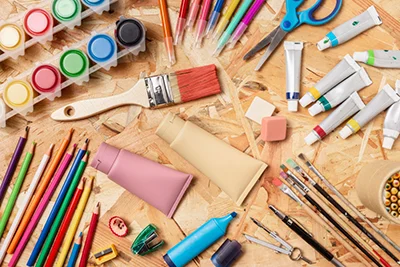
Menu
Menu


Discover the vast world of Crafting Materials and SVG Files, where the right material can transform a simple design into a masterpiece. Imagine the possibilities when each project is paired with the perfect material—vinyl, fabric, paper, and more. This guide will navigate you through selecting the ideal substrate for your SVG creations, ensuring every piece is not only beautiful but durable. Delve into a journey where material meets design, and creativity knows no bounds. Get ready to elevate your crafting projects to new heights with insights into matching SVG files with their ideal counterparts.
Scalable Vector Graphics (SVG) files revolutionize crafting, offering unparalleled flexibility across a multitude of projects. These digital designs cater to a broad spectrum of creative endeavors, from intricate paper art to durable vinyl decor. The key to harnessing their full potential lies in the art of material selection. Choosing the correct materials not only ensures the longevity and quality of your creations but also elevates the aesthetic appeal. Whether you’re etching glass, fashioning custom apparel, or embellishing home decor, the material’s compatibility with your SVG design is paramount. This guide illuminates the path to selecting ideal materials for your SVG projects, guaranteeing results that are both beautiful and lasting.
The selection of materials for SVG file projects holds transformative power, directly influencing both aesthetic and functional outcomes. Materials not only dictate the visual appeal but also the durability and application of the final product. For instance, choosing the right type of vinyl—be it adhesive or heat transfer—can make or break a project’s success on different surfaces. Similarly, fabric projects demand materials that complement the intricacies of SVG designs, ensuring clarity and longevity in wearables and decor. The paper’s weight and texture play a pivotal role in paper crafts, where precision and finesse are paramount. Each material brings its unique properties to the table, from the sheen of vinyl to the weave of fabric, impacting the project’s overall look and feel. Understanding these nuances allows crafters to make informed decisions, optimizing the symbiosis between SVG designs and materials, and elevating the quality of their creative ventures.
Start with selecting a high-quality vinyl suited for your project’s surface. Use your cutting machine to trim the SVG design, adjusting settings for vinyl’s thickness. Weed excess vinyl, apply transfer tape, and smoothly adhere your decal. Tips: Test a small piece first; ensure surface cleanliness for best adhesion.
Choose fabric that complements the SVG design, pre-washing if necessary to prevent shrinkage. Mirror your SVG file in the cutting software for correct orientation. Cut the design from iron-on vinyl, then iron onto your fabric under a cloth. Remember to peel the carrier sheet off when cool for a flawless finish.
Opt for paper that’s sturdy yet pliable enough for intricate cuts. Adjust your cutting machine for paper’s weight, performing a test cut. Carefully remove the design using a weeding tool, then assemble using adhesive or 3D foam pads for dimension. Highlight: Precision in cutting depth prevents tearing and ensures clean lines.
For wood projects, select a thin, smooth plywood and use a strong grip mat. Leather works beautifully for embossed SVG designs, requiring a deep-cut blade. Acrylic pieces, ideal for durable ornaments or keychains, necessitate a specialized cutting blade. Always test cut settings on scrap material to fine-tune your approach.
Vinyl is a versatile material widely used in crafting with SVG files. There are primarily two types: adhesive vinyl for decals and stickers, and heat transfer vinyl (HTV) for fabric applications. Adhesive vinyl works well for custom wall decals, car stickers, and personalized home decor items. HTV is ideal for creating custom apparel, tote bags, and cushion covers. When working with vinyl, consider the project’s end use—outdoor items require waterproof and UV-resistant vinyl, while indoor items may not. Experimenting with glitter, metallic, or matte finishes can add a unique touch to your creations.
Fabrics offer a canvas for personal expression with SVG designs, especially when using HTV. Choose fabrics based on their compatibility with heat transfer—cotton, polyester, and blends work best. For intricate designs, a fabric with a tight weave ensures crisp transfers. Projects like personalized t-shirts, fabric banners, and custom patches highlight the fabric’s versatility. Pre-washing materials without fabric softeners is crucial to remove sizing and prevent shrinkage post-application. Testing cut settings on a small fabric piece can save time and materials.
Paper crafting with SVG files opens a world of creativity, from detailed greeting cards to elaborate scrapbook layouts. Selecting the right paper type—cardstock, vellum, or specialty paper—depends on the project’s requirements. Heavier cardstock is perfect for 3D models and cards, while lighter paper suits intricate designs better. Adjusting blade depth and pressure is key to clean cuts. Consider paper’s texture and weight for the desired outcome, and always perform a test cut with new materials.
Exploring less conventional materials like wood, leather, and acrylic with SVG files pushes creative boundaries. Thin plywood or balsa wood can be cut for ornamental pieces or signage. Leather, both faux and genuine, offers rich textures for bracelets, keychains, or book covers. Acrylic, cut into shapes or letters, creates durable and stylish decor. Each material requires specific cutting blades and settings, emphasizing the need for experimentation and adjustment. These projects stand out for their texture and durability, adding depth to any crafter’s portfolio.
Selecting the right material for SVG projects hinges on understanding the project’s purpose. Durability is paramount for items intended for outdoor use or frequent handling. Consider the material’s texture and finish to ensure compatibility with the SVG design’s intricacy. For wearable projects, factor in the fabric’s heat tolerance and washability. Testing a small piece beforehand can prevent wasted effort and materials. Also, evaluate the environmental impact of your material choices, opting for sustainable options when possible. Balancing aesthetics, functionality, and sustainability leads to successful and satisfying SVG crafting projects.
The harmony between SVG files and their corresponding materials is crucial for crafting success. This alignment ensures projects not only look stunning but also endure. Embrace the journey of experimentation—mixing various materials with diverse SVG designs can lead to unexpected and rewarding outcomes. Let your creativity flourish by stepping out of your comfort zone, and you’ll discover new techniques and possibilities. Remember, every project is an opportunity to learn, grow, and, most importantly, create something truly unique. Dive into your next crafting adventure with confidence, eager to explore the vast potential that awaits with SVG files and the perfect materials.
